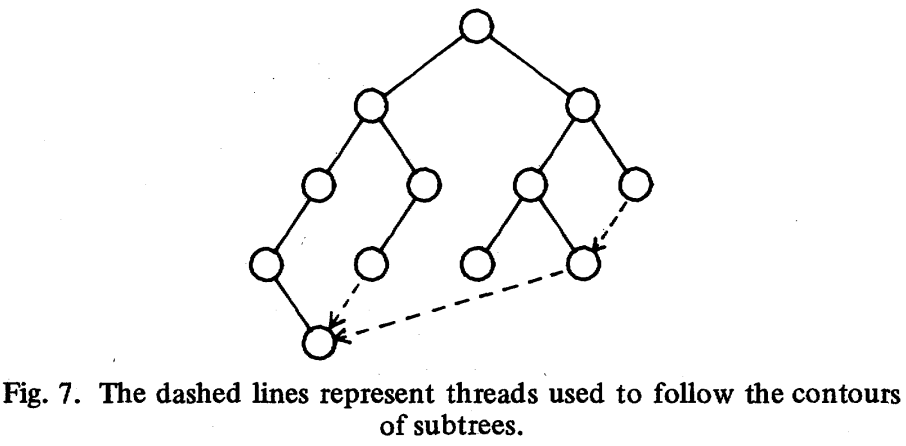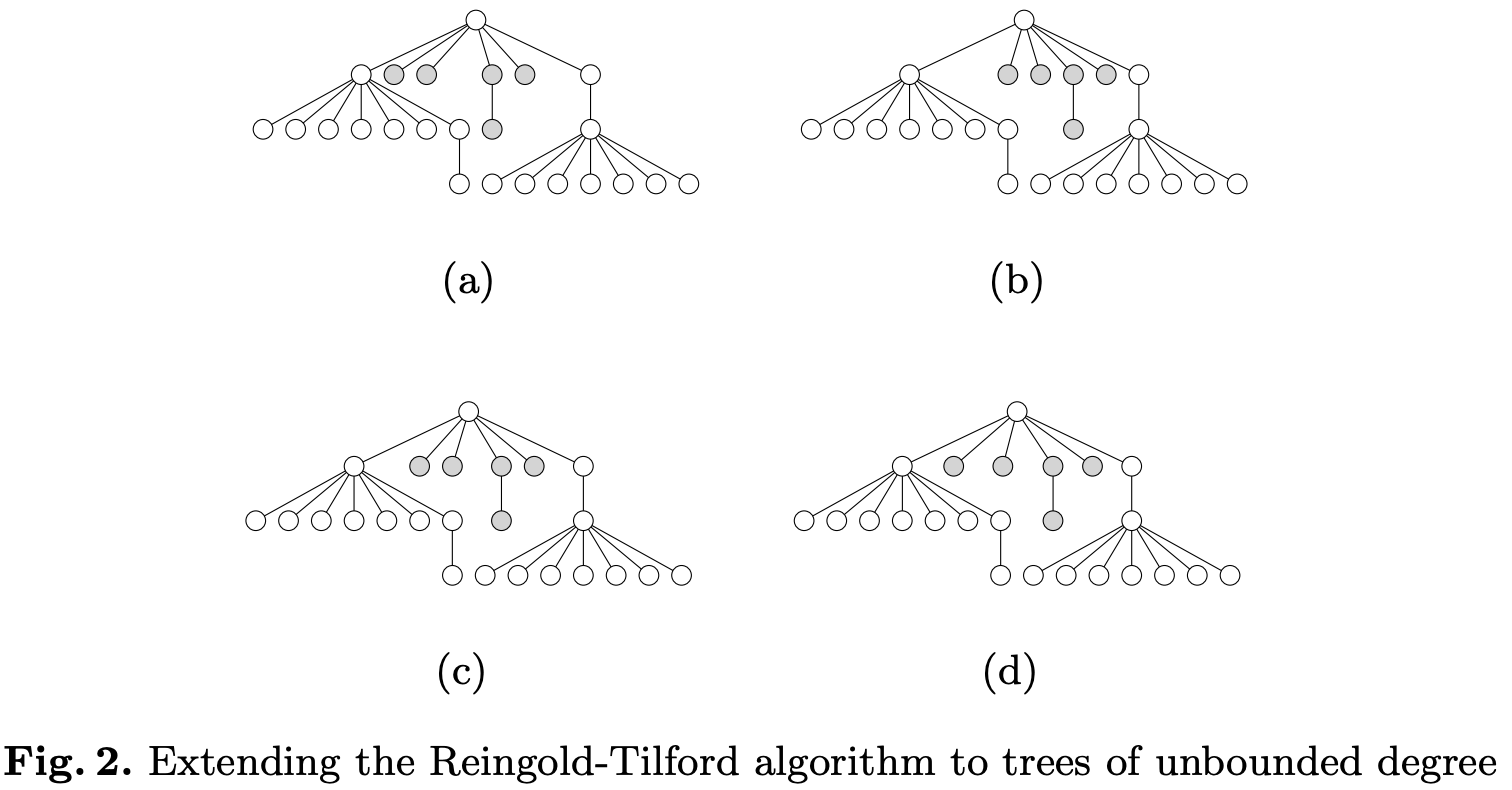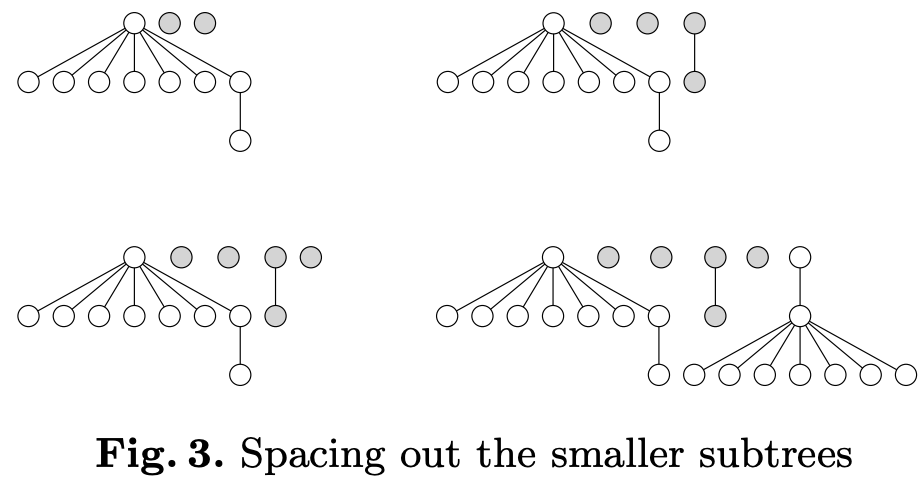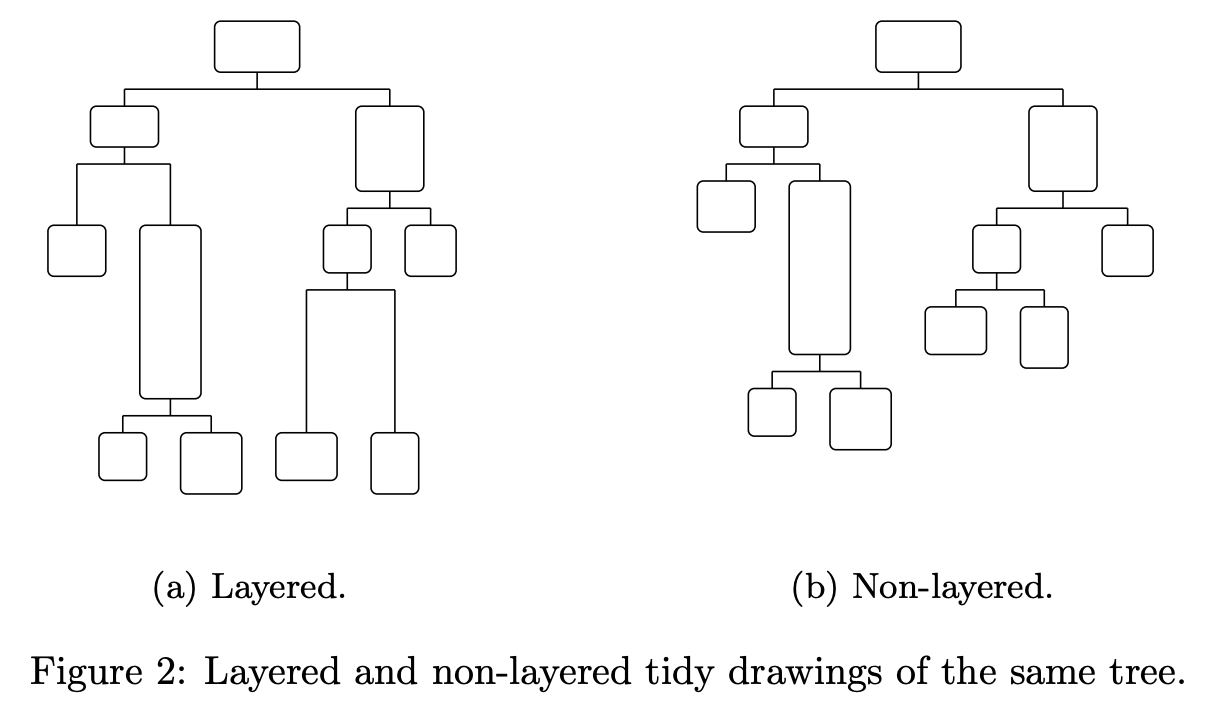课程 23 - 思维导图
有很多无限画布应用都提供了对于思维导图的支持,例如 miro、excalidraw、canva、xmind 等等。 我非常喜欢 excalidraw 的分类方式,它把思维导图又细分成了三种子类型:
- Spider mapping 适合头脑风暴场景,从最中心的核心主题伸展开去,形似一张蜘蛛网。从渲染效果上看,mermaid 提供的也是这种类型。
- Tree mapping
- Flow map
| Spider mapping | Tree mapping | Flow map |
|---|---|---|
 |  |  |
这里我们仅讨论最后一种类型。
尽管思维导图最终的展现形式存在很大差异,但从数据结构上看,思维导图就是一棵树形结构,由节点和边组成。markmap、mermaid 通过将 markdown 转换成这种结构。树是一种特殊的图结构,也有一些针对有向图的布局算法例如 dagre 和 elkjs 等等,这里就不考虑了。
{
"id": "Modeling Methods",
"children": [
{
"id": "Classification",
"children": []
}
]
}针对这类数据,d3-hierarchy 提供了一系列开箱即用的算法,同样我们仅关注 d3-tree 这一种。
d3-tree
我们先添加两个限制,后续会介绍如何突破它们:目标为二叉树,所有节点尺寸都相同(或者说不存在尺寸)。
d3-tree 的实现思路来自:Tidier Drawings of Trees,它在前人的研究基础上提出了几个美学标准:
- Aesthetic 1: Nodes at the same level of the tree should lie along a straight line, and the straight lines defining the levels should be parallel.
- Aesthetic 2: A left son should be positioned to the left of its father and a right son to the right.
- Aesthetic 3: A father should be centered over its sons.
- Aesthetic 4: A tree and its mirror image should produce drawings that are reflections of one another; moreover, a subtree should be drawn the same way regardless of where it occurs in the tree.
关于前三个标准的演变改进过程可以阅读 Drawing Presentable Trees,它使用 Python 代码和配图详细地展示了之前论文的算法思路。比如实现第三条标准很简单,就是使用后序遍历,将父节点的 x 坐标设置为所有子节点中最左和最右的中点:
// @see https://github.com/d3/d3-hierarchy/blob/main/src/tree.js#L150
var midpoint = (children[0].z + children[children.length - 1].z) / 2;能很直观的看出来它仍然不够对称,整体偏右,这也引出了标准四:
| As narrowly as possible | A parent should be centered over its children |
|---|---|
 |  |
居中父节点这一操作有可能与它的兄弟节点位置冲突,此时我们需要将子树整体移动,但如果用下面的递归方式,算法复杂度会来到
def move_right(branch, n):
branch.x += n
for c in branch.children:
move_right(c, n)此时我们需要为节点增加一个 mod 属性,这样居中父节点操作可以暂时不考虑冲突,后续再进行移动。这样避免了递归,算法复杂度回到了 prelim 属性,这个名称来自:A Node-Positioning Algorithm for General Trees:
// @see https://github.com/d3/d3-hierarchy/blob/main/src/tree.js#L67
function TreeNode(node, i) {
this._ = node; // final position: _.x
this.parent = null;
this.children = null;
this.z = 0; // prelim
this.m = 0; // mod
}正因为使用了后序遍历:
function tree(root) {
var t = treeRoot(root);
t.eachAfter(firstWalk);
t.eachBefore(secondWalk);
}在第二次前序遍历中递归累加 mod,完成向右平移得到最终的位置 _.x。这对应着原始论文中的 PETRIFY 步骤:
// @see https://github.com/d3/d3-hierarchy/blob/main/src/tree.js#L164
function secondWalk(v) {
v._.x = v.z + v.parent.m; // final x
v.m += v.parent.m;
}这里需要引入 contour 的概念,例如下左树的右轮廓为 [1, 1, 2],下右树的左轮廓为 [1, 0, 1]。当我们需要避免这两棵子树重合在一起,只需要比较这两个轮廓就能得出需要将右树向右移动多少距离,在这个例子中移动距离是 2。

def push_right(left, right):
wl = contour(left, lt)
wr = contour(right, gt)
return max(x-y for x,y in zip(wl, wr)) + 1得到子树轮廓的算法依然需要递归,因此复杂度为 thread 的概念,下图中虚线就表示这种有别于父子的关系,将每棵子树原本可能并不实际存在的轮廓勾勒了出来:

function TreeNode(node, i) {
this.t = null; // thread
}这样在计算 contour 时就可以跨越实际的层次结构,直接通过 thread 获取,这样复杂度也降为了
// @see https://github.com/d3/d3-hierarchy/blob/main/src/tree.js#L15C1-L24C2
function nextLeft(v) {
var children = v.children;
return children ? children[0] : v.t;
}
function nextRight(v) {
var children = v.children;
return children ? children[children.length - 1] : v.t;
}复杂度证明
让我们来回顾一下该算法。首先进行一趟后序遍历计算节点的相对坐标和 thread,然后进行一趟前序遍历累加 mod,确定每个节点的绝对坐标位置。不难看出每个节点在这两趟遍历中都只会被访问一次。因此只需要确定第一趟遍历中轮廓扫描的复杂度。
在原论文中对这一步的复杂度也进行了数学分析。

接下来只需要证明
作者提出了这样一个假设:
使用归纳法,
根据定义(加上根节点):
代入:
因此:
扩展到 N 叉树
我们可以从左到右依次处理平移子树,但这样做的结果如下图 (a),我们也可以增加一趟从右到左的遍历,但这样又会出现 (b) 的情况。我们希望实现 (d) 的效果:

A Node-Positioning Algorithm for General Trees 提出了一种方案,值得一提的是 d3-tree 的代码结构、变量名基本复用了这篇论文。下图展示了子树添加过程中,重新布局的效果:

apportion 函数是整个布局核心的“子树间对齐逻辑”,它负责比较当前子树与前一个子树的轮廓;如果它们重叠,就给当前子树加一个 shift;更新 modifier 使得后代节点也随之调整;同时平滑中间的 modifier,避免“断层”。
function apportion(v):
leftMost = firstChild(v)
rightMost = lastChild(v)
defaultAncestor = leftMost
for each child w from second to last:
leftSibling = previousSibling(w)
# Initialize contour pointers
vip = w
vim = leftSibling
sip = vip.mod
sim = vim.mod
# Compare right contour of vim and left contour of vip
while vim ≠ null and vip ≠ null:
shift = (vim.prelim + sim + separation) - (vip.prelim + sip)
if shift > 0:
# Move current subtree right
moveSubtree(ancestor(w, v, defaultAncestor), v, shift)
sip += shift
# move to next lower level
vim = rightmostChild(vim)
vip = leftmostChild(vip)
sim += vim?.mod or 0
sip += vip?.mod or 0
# update default ancestor
if rightMostChild(vim) ≠ null and leftMostChild(vip) == null:
defaultAncestor = ancestor(w, v, defaultAncestor)继续在节点上增加属性,存储 shift:
function TreeNode(node, i) {
this.c = 0; // change
this.s = 0; // shift
this.A = null; // default ancestor
this.a = this; // ancestor
}其中 moveSubtree 将以 wp 为根的子树整体右移 shift 单位。
// @see https://github.com/d3/d3-hierarchy/blob/main/src/tree.js#L28C10-L28C21
function moveSubtree(wm, wp, shift) {
var change = shift / (wp.i - wm.i);
wp.c -= change;
wp.s += shift;
wm.c += change;
wp.z += shift;
wp.m += shift;
}该实现的复杂度为
如果需要在水平方向展示,只需要转置一下坐标系,将节点的 x/y 进行交换即可。
d3-flextree
上述算法有一个很明显的限制,它要求所有节点都是同样的宽高,正如很多 d3-tree 的例子都使用同样大小的圆作为节点。这里非常推荐阅读 Drawing Non-layered Tidy Trees in Linear Time 和 High-performance tidy trees visualization。

d3-flextree 正是为了解决这一问题,markmap 使用了它。
A limitation of that algorithm is that it applies to trees in which all of the nodes are the same size. This is adequate for many applications, but a more general solution, allowing variable node sizes, is often preferable.
效果如下:
@antv/hierarchy
@antv/hierarchy 中的 mindmap 算法和 mindmap-layouts 提出了以下美学要求:
- 根节点居中
- 子节点可左右分布(通常左右对称,或根据
getSide设定) - 同一层级节点按垂直方向均匀排列
它也支持定义节点尺寸,并没有使用轮廓扫描方案,大致步骤如下,整个算法复杂度为
- 第一遍:快速设置一个基础的 x 坐标。
- 第二遍:从下到上计算每个子树需要的垂直空间。
- 第三遍(调整阶段):从上到下,利用计算好的空间信息,为所有子节点安排不重叠的 y 坐标。
- 第四遍:再次从下到上,根据子节点的最终布局反过来微调父节点的位置,实现垂直居中的效果。
效果如下:
[WIP] 交互
思维导图有很多特殊的交互,包括点击节点展开/收起子节点。